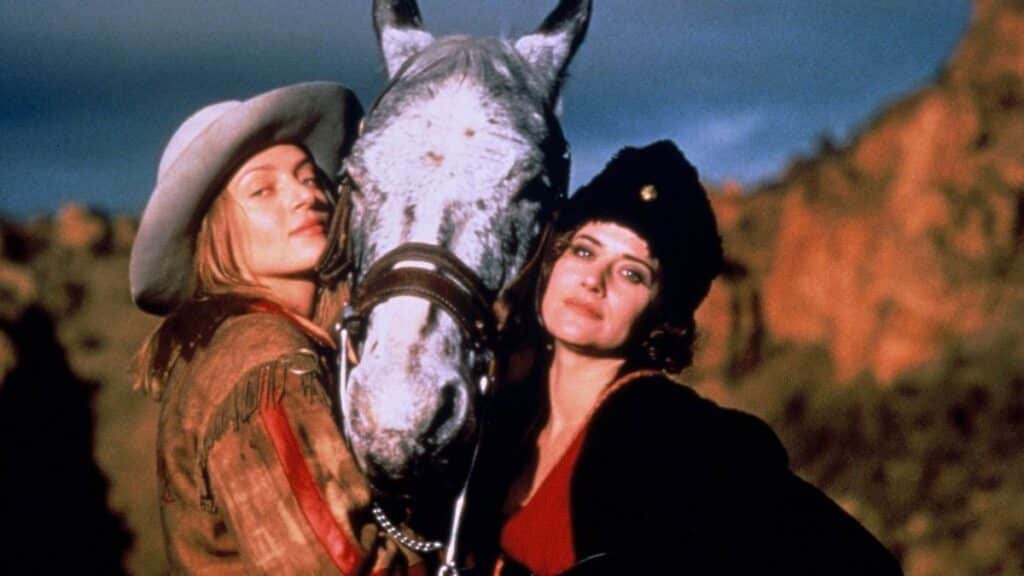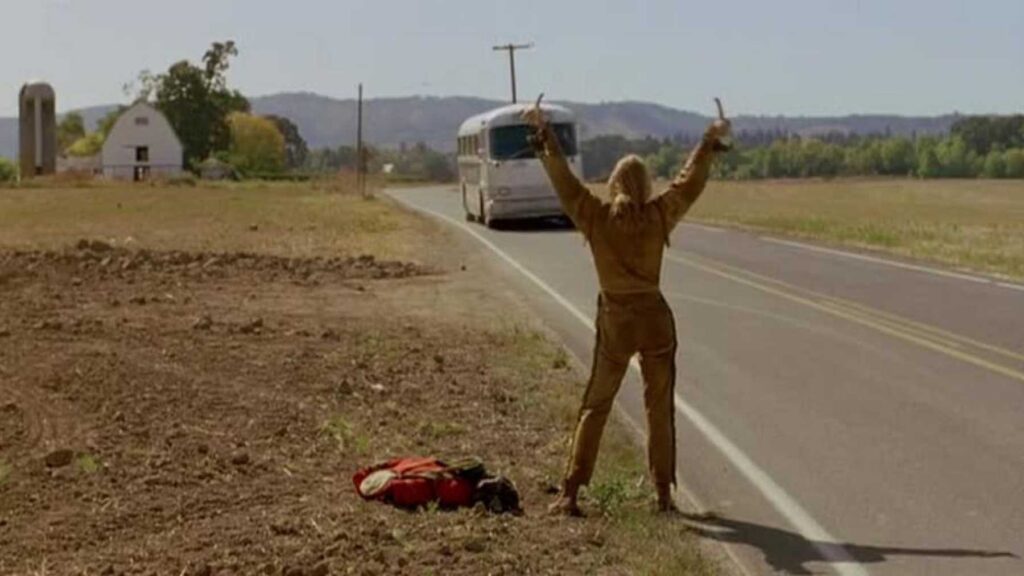Read also:
How to Watch FX Live Without CableHow To Watch AMC Without CableHow to Watch ABC Without CableHow to Watch Paramount Network Without CableEvery month, we at The Spool select a filmmaker to explore in greater depth — their themes, their deeper concerns, how their works chart the history of cinema and the filmmaker’s own biography. For June, we celebrate the birthday (and the sensitive, insightful eye) of Gus Van Sant. Read the rest of our coverage here.
When Gus Van Sant‘s Even Cowgirls Get The Blues first premiered at the Toronto International Film Festival in 1993, there was a heavy sense of disappointment in the air. In his review, Roger Ebert recalled, “I remember the hush that descended upon the theater during the screening; it was not so much an absence of noise as the palpable presence of stunned silence.” Critics were gagged. This wasn’t My Own Private Idaho! How offensive!
This Western road folktale, adapted from Tom Robbins’ 1976 novel, tells the cross-country travels of one Sissy Hankshaw (Uma Thurman), a free-spirited model/hitchhiker blessed with enormous thumbs. We glimpse Sissy’s life from passenger seat to passenger seat as she passes through towns and the lives of the people in them. Suddenly, a call from an eccentric former employer (John Hurt as “The Countess”) sets us out on the main story of how she came to be at The Rubber Rose Ranch.
Upon arriving at the “beauty” ranch, Sissy meets a group of radical cowgirls squatting on the land, protecting the endangered mating grounds of whooping cranes. In living amongst the cowgirls and falling for the captivating Bonanza Jellybean (Rain Phoenix), Sissy comes to find new and queerer understandings of herself, love, and home.

“Missing from Cowgirls is the poetry of yearning and desperation running through Van Sant’s My Own Private Idaho,” wrote Deborah Young of Variety. “How did this happen?,” Ebert asked. “Cowgirls has been directed by Gus Van Sant, whose most recent features were Drugstore Cowboy and My Own Private Idaho, both fine, strong-minded, creative films.” Caryn James of The New York Times called it “one of the more intriguing failures of its day.”
I can’t think of a queerer descriptor than ‘intriguing failure.’ It describes queer existence well. Queer people are often seen as fabulous-but-not-quite-humans; almost-citizens. When Even Cowgirls Get The Blues failed to meet their standards of what made a respectable queer film, critics were puzzled how the golden boy they were all but ready to canonize could displease them so.
As Tim Stevens succinctly discussed in his retrospective of Drugstore Cowboy, Van Sant earned his initial acclaim for a laconic, still, and grounded realist cinematic style. My Own Private Idaho furthered this push into “poetic” cinema, merging mainstream independent cinematic senibilities with queer narrative. Ebert calls Van Sant “strong-minded” and “creative” because the films are easily read as steeped in Western cinematic traditions.
They aren’t wrong for praising them for these qualities. Van Sant has a wonderful eye for stillness, but to do so in the context of critiquing a noticeably more flamboyant film reveals the masculinist and heteronormative contours of film criticism of the mid-1990s.
For, if Cowgirls is not “strong-minded,” “poetic,” “laconic,” or “grounded” then we can assume they mean it is “weak-minded,” “over-dramatic,” “verbose,” and “unreal” (or worse, “hysterical”), all words commonly used to criticise and censor queers and queer cinema. Such descriptors carry value hierarchies with them. We need to recognize that the perceived strength behind the words critics used to describe Drugstore and Idaho comes from their adherence to masculine ideals of reason, economy, and control.
For critics, the weaknesses stem from a supposed lack of narrative clarity. Ebert experiences time in the film as “incoherent bursts of disconnected and arbitrary events” because Cowgirls denies any sense of clear narrative progression for the three-fourths of its runtime. Rather than marching toward a “point,” “spending” its time “wisely,” the film gives us little segments held together by ellipses that elicit a creative impression of Sissy’s life rather than a realistic portrayal.
Sissy circuits around the US, in and out of car doors, not really knowing where she is going or whom she’s with. These aren’t “disconnected” and “arbitrary” moments, they are blended and blurred together to help use relax into Sissy’s queer mode of being where time and distance collapse and there’s only The Road and the prickling of her thumbs. Without this blurring sensation, we wouldn’t know when something changes in Sissy as she starts to settle down at the ranch.
In Ebert scolding the film for being in a “timewarp,” we see traces from the mid-1990s of what we now know is an unfounded optimism in the progress of late capitalism. Van Sant and other directors in New Queer Cinema were welcomed and heralded for their presentness, for their realist looks at “the now.” That Sissy seems to be Blache DuBois as a ‘90s queer person in a ‘60s road-Western doesn’t strike these critics as artistically interesting, because it celebrates the temporal-disjointedness of queer being.
Van Sant and other directors in New Queer Cinema were welcomed and heralded for their presentness, for their realist looks at “the now.”
Rather being than a composite of contemporary signs, Sissy and indeed all the characters in Cowgirls have queer identiies because they are un-conventional collages of different times and references to create an identity they fit into unlike the dominate ones enforced by society. These time-out-of-time qualities add to Cowgirls’ magical realist tone by making all the characters seem slightly out of place yet logical within the world.
Only now do we see the radicalness of an exclusively queer-femme space that violently resists police. How no one could see the feminist links between the cowgirls and their standoff with police and the Waco massacre that happened only a few months before the film’s release is a puzzlement.
But now there’s been enough distance from the 1990s and even more from the 1960s to know now that the cycles of conservatism and economic collapse repeat and intensify themselves. Ironically, Sissy seems almost more-real when watching her now, which speaks to an unexplored prescience underneath Cowgirls. We can more clearly see the cultural fissures that in 1993/4, a queerness beyond desire still needed acceptance in the feminist movement.
Critics and the audiences they had taught were not prepared for the playful queer perspective of Even Cowgirls Get The Blues. Kenneth Turan of The Los Angeles Times chided, “playfulness ceases to have a serious purpose when it takes itself too seriously,” as someone says [in the film]. For Turan, this is “a theory this unfortunate movie goes way out of its way to prove.” But patriarchal cultural criteria prevent critics like the ones we’ve discussed from interpreting this quote correctly.

These critics feel like playfulness should have “serious purpose,” that all cinematic elements should be efficiently used, economically chosen, and work towards a final result or product. Instead, films like Even Cowgirls Get The Blues ironically invert the meaning of this quote.
It takes its playfulness seriously, working hard to be noticeably playful, as evidenced by the elements of magical realism and scenes with Uma Thurman in a crane costume. And in so doing, Cowgirls renders play paradoxically pointless and actually more playful, because it is free to be as it is.
“What I am sure of is that Even Cowgirls Get the Blues is one of the more empty, pointless, baffling films I can remember, and the experience of viewing it is an exercise in nothingness,” said the ever-cheerful Ebert at the end of his review. Instead of seeing the queer nature of the film as ‘somethings’, those cultural biases prevent more overtly queer texts like Cowgirls from being properly understood in their time.
This is the kind of deeply ingrained homophobia that needs to be excavated from cultural criticism. Does calling out the un-queer blinders built up by decades of criticism make Cowgirls a perfect film? Absolutely Not. The film has problems, but not the ones critics focused on.
No major critic bothered to adequately address the Orientalist desert shaman character of The Chink, played by the venerable Noriyuki “Pat” Morita. I will give Van Sant the benefit of the doubt and say that what was probably a more expanded racist portrayal of Chinese people got lost in last-minute editing. Instead, we have a truncated racist portrayal of Chinese people in a desperate attempt to address the noticeable lack of an Indigenous presence in this Western.
Queer utopias should not be built on structures of racism. Queer utopias should not disrupt the environment like ranch does. These are real-world issues we can unroot once we accept a queer film for its queerness and go deeper in our criticism. Heteronormative expectations of what is or isn’t “good” “queer” “cinema” leaves viewers like Young feeling like the film stays “on the surface, without attempting any exploration of painful depths.”
But it’s the queer love and loss in the film that give the cowgirls the blues. To understand this clearly, it’s important that we meet queer films and filmmakers on their own terms. As critics and critical viewers, it’s important we suspend the value judgments we have been taught so we can truly experience the play and pleasures of queer narrative time. Critics can learn a lesson from Sissy. The most enjoyable way to travel on the road of cinema is to be open to whatever direction comes your way and listen to the pricking of your thumbs.